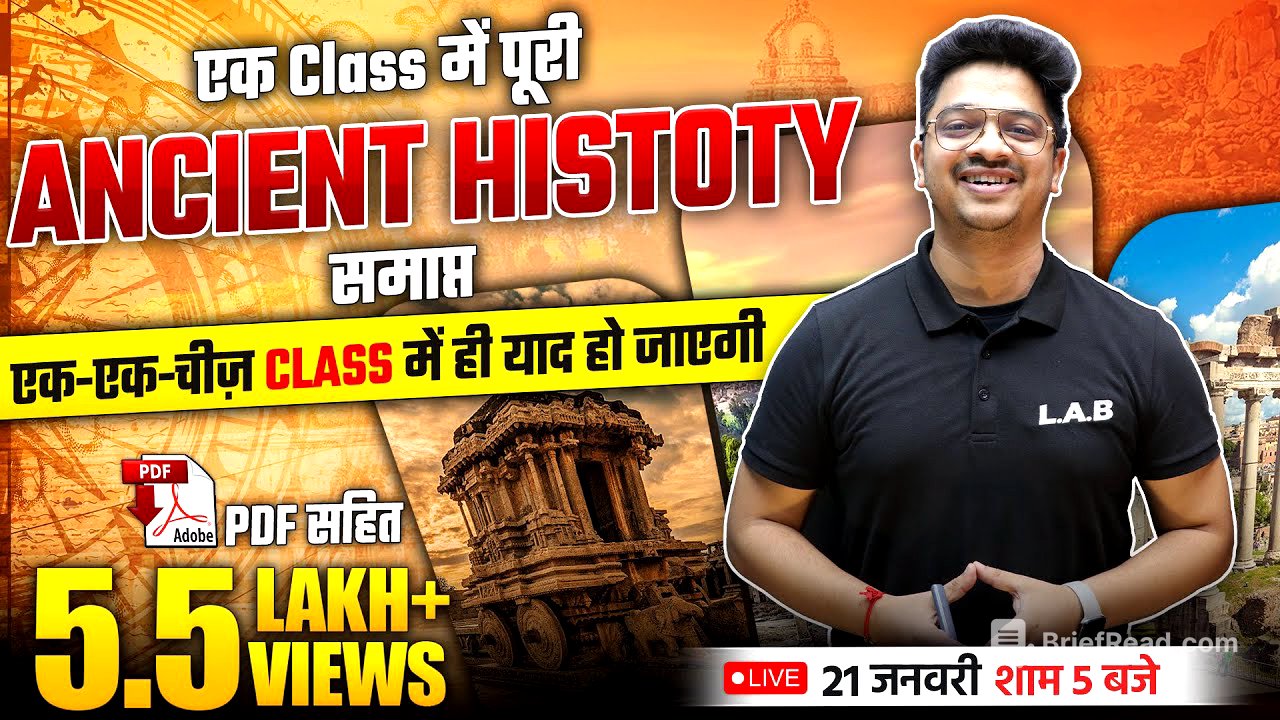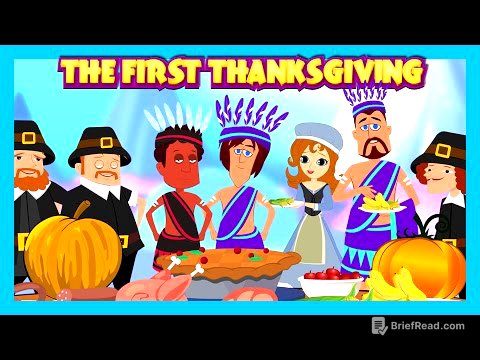TLDR;
This YouTube video by SSC LAB, hosted by Manu Srivastava, provides a comprehensive overview of Ancient Indian History, covering the Indus Valley Civilization, the Vedic Period, the rise of Mahajanpadas, and the Mauryan Empire. The lecture aims to provide a story-like understanding of historical events, focusing on key facts relevant for exams. It also emphasizes the importance of understanding the underlying reasons behind historical developments.
- Covers Indus Valley Civilization, Vedic Period, Mahajanpadas, and Mauryan Empire.
- Focuses on exam-relevant facts and story-like understanding.
- Notes available on Telegram channel.
- Free MCQ test on the discussed topics on the coming Sunday.
Start [3:17]
The session will cover the entire ancient Indian history, and the presenter encourages viewers to listen attentively like a story. The aim is to build confidence in the subject, and notes will be provided on the Telegram channel. A free MCQ-based revision class is scheduled for the coming Sunday.
Indus Valley Civilization in Hindi [4:57]
The Indus Valley Civilization (2700-1900 BC) is discussed, emphasizing that historical knowledge is based on interpretations of discovered artifacts. The civilization is also known as Harappan Civilization (due to the first discovered city, Harappa) and Bronze Age Civilization (due to the use of bronze tools). The presenter highlights that all three names refer to the same civilization. The presenter also highlights the importance of the Indus river, also known as Sindhu.
Harappan Civilization in Hindi [14:51]
The lecture discusses the geographical spread of the Indus Valley Civilization, highlighting sites near rivers. The presenter explains that the civilization flourished near rivers due to the need for water for agriculture, which replaced a nomadic lifestyle of hunting. Key cities like Kalibanga, Harappa, and Mohenjo-daro are mentioned, and the presenter asks which river Harappa is situated on.
Mohenjo Daro Explain in Hindi [16:28]
The presenter discusses how the civilization was discovered during railway line construction by the British. The discovery of seals, metal plates with animal figures, provided insights into their life. The presenter asks the audience to identify the animal on the seal, explaining that different interpretations are common in history. The presenter also explains that the presence of animals on seals indicates animal domestication.
kalibangan History in hindi [17:51]
The presenter discusses key features of various cities. Harappa was discovered by Daya Ram Sahni and is located on the Ravi River in Pakistan, where a bullock cart was found, indicating animal domestication. Mohenjo-daro features the Great Bath, interpreted as a ritual bathing site. Kalibangan had fire pits (havan kund) and camel bones.
Surkotada Indus Valley Civilization [21:26]
Surkotada had horse remains, while Kalibangan also had camel bones. A wooden plough was found in Kalibangan, with the presenter using a memory trick to remember this fact. Lothal had a dockyard and chess pieces, indicating trade and recreation. Banwali had clay statues, remembered by associating "Banwali" with "Mali" (gardener) who works with clay.
City Architecture Indus Valley Civilization [22:02]
The presenter contrasts modern housing with the planned architecture of the Indus Valley Civilization. Houses were built in a grid system for self-cleaning roads and proper ventilation. The civilization had covered drainage systems with manholes. Cities were divided into elevated areas for the elite ("Citadel") and lower areas for commoners. Dholavira was uniquely divided into three parts.
Ancient India History - Vedic Period [35:05]
The presenter discusses the end of the Indus Valley Civilization, presenting various theories like earthquakes, floods, and Aryan invasions. Karl Marx's theory of Aryan invasion is mentioned, describing Aryans as hunters from Central Asia who migrated to the fertile Indus Valley. The presenter explains how the Aryans established the Varna system (social hierarchy) based on perceived qualities and lineage.
Vedic Books Explains [50:29]
The presenter explains that the Vedas (Rigveda, Samaveda, Yajurveda, and Atharvaveda) are not just books but "Samhitas" (collections) requiring additional texts for understanding. Each Veda has Upanishads, Brahmanas, and Aranyakas. Vedas contain hymns and guidelines for life, while Upanishads explain the "why" behind Vedic practices, often with scientific reasoning. Brahmanas define the verses, and Aranyakas are for those seeking detachment and meditation in forests.
A brief history of VEDAS [57:34]
The presenter explains the structure of the Rigveda, which is a collection of 10 books (Mandals) containing hymns (verses). The Rigveda mentions Indra most frequently, considering him the chief deity. The Gayatri Mantra is taken from the Rigveda. The presenter also explains that the Vedas are verified using Zend Avesta, an ancient Iranian religious text.
Brahamanas History Explain [1:15:21]
The presenter explains that Brahmanas explain the verses of the Vedas, including the meaning of "Om" and its vibrations. They also contain scientific knowledge, including astronomy and geometry related to the construction of Havan Kunds (fire altars).
Types of Vedic literature [1:07:02]
The presenter differentiates between Shruti (revealed knowledge) and Smriti (remembered knowledge) literature. Shruti, including the Vedas, Brahmanas, Aranyakas, and Upanishads, is considered eternal and unchanging. Smriti, including Vedangas, Darshanas, Puranas, Itihasas, Upvedas, Tantras, and Agamas, changes with time.
Alexander Invasion of India in Hindi [1:27:20]
The presenter discusses the political structure of the Vedic period, starting from the family unit (Kula) to the kingdom (Rajya). The presenter explains that the king's territory was defined by the grazing range of his cows, leading to conflicts. These conflicts led to the emergence of 16 Mahajanpadas (major kingdoms). The presenter also discusses the social structure, highlighting the respected position of women and the absence of child marriage.
Ancient India History - Period of Mahajanpadas [1:34:36]
The presenter explains that the 16 Mahajanpadas emerged due to the increasing use of iron, which led to better weapons and agriculture. The presenter also explains that the Mahajanpadas were located in the fertile regions of Bihar and Orissa, where iron was abundant. The presenter also explains that the four most powerful Mahajanpadas were Magadha, Kosala, Vatsa, and Avanti.
Ancient Indian History of Magadha Empire | Bimbisara [1:44:22]
The presenter discusses how Magadha became the most powerful Mahajanpada through strategic alliances and conquests. The Haryanka dynasty was established in Magadha, with Bimbisara as its first ruler. Bimbisara expanded his kingdom through marriages, such as with Kosala Devi, which brought Kosala into Magadha's control.
Haryanka Dynasty and Ajatshatru History in Hindi [1:47:32]
The presenter explains that Ajatashatru, Bimbisara's son, killed his father to ascend the throne. Ajatashatru then conquered Kosala and Vaishali. Udayin, Ajatashatru's son, also killed his father, leading to public resentment and the overthrow of the Haryanka dynasty. The Shishunaga dynasty then took over, with Shishunaga conquering Avanti. The Nanda dynasty followed, with Mahapadma Nanda as its first ruler. Dhana Nanda, the last Nanda ruler, was overthrown by Chandragupta Maurya.









